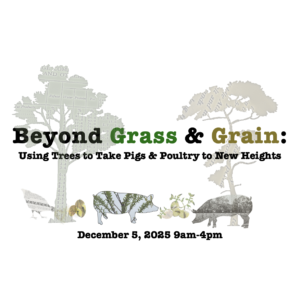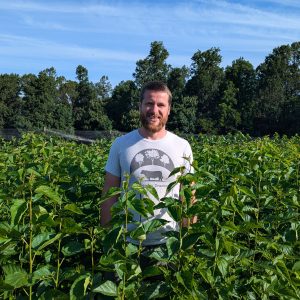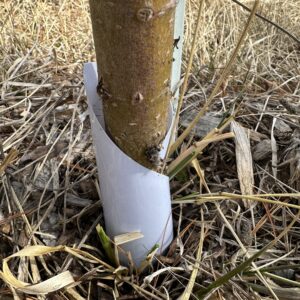Why mulberry?
Mulberry fruits are hands-down, the most important, most valuable tree crop for feeding pigs and poultry on pasture and have leaves that are among the most nutritious anywhere, being both high in protein and highly digestible. And the tree is easy to grow.
The importance of mulberry fruits stems from the fact that they become available in early summer, months earlier than almost any other tree crops. You have tons of options to choose from in the fall (apples, chestnuts, persimmons, etc), but early summer has very few other options. And mulberry happens to be a great one, as it bears heavily and the fruits are uniquely high in protein, more than about any other tree fruit. This makes them an ideal feed for pigs and poultry alike. Where the fruits are too low in certain proteins or amino acids, the leaves make up the difference.
But not all mulberry trees are the same. Roughly half of all seedlings are male, which release lots of pollen and bear no fruit, while all of our trees are female, fruiting trees. Further, fruit characteristics can be vastly different from one tree to the next, and clonal propagation ensures you have consistent high-yielding, high-quality trees. By careful planning, you can provide fruit drop from June to August for our area, with that timeline moving earlier in the season as you go south, and later as you go north.
What is tissue culture?
Tissue culture is a way of propagating very small pieces of plants, just like with traditional softwood cuttings, but smaller and done in a very controlled environment. All of our mulberry trees are clonally propagated by tissue culture and then grown out in our nursery to get to size. Tissue culture propagation allows us to offer robust, low-maintenance trees with the highest qualities and consistency, while also propagating at scale so we can offer volume discounts. Accidentally cutting a grafted tree below the graft line is a serious issue on a grafted tree, but a tree grown from tissue culture will retain the same genetics as it regrows.
What is popcorn disease?
Mulberry popcorn disease is a fungal infection that causes distinctive swollen growths on the fruit, which look like popcorn kernels, rendering them unusable. The issue is common in southern states, and not a concern in northern states. The disease spreads through spores, particularly in humid conditions. Good air circulation (pruning up), maintaining good ground cover (tall grass can potentially limit the soil-born spores from getting up to the immature fruit), and having fruits, especially infected fruits, picked up by livestock are all good practices to reduce the issue.
Aren’t mulberries invasive? White mulberries (Morus alba) are indeed non-native, and we would not recommend them for conservation plantings. However, we’re talking here about using them for food production, in which different standards need to be applied. We are aiming to use mulberries to cut the use of corn and soybeans, two crops that are commonly genetically modified to support no insects, no biodiversity, and are grown in strict monocultures. Yes, they will likely spread some, such as to nearby fencelines. But that cat was left out of the bag as early as the 1600’s, when orus alba was imported to feed silk worms, and they’ve been hybridizing with native mulberries ever since. They were also planted extensively throughout the South for pig and poultry feed for centuries. Read more here.We believe that the positive side-effects, like wildlife food, habitat and carbon sequestration are worth the trade-off.
Will I need male mulberry trees around to pollinate my female trees? Most mulberry cultivars, including all that we list, are self-fertile meaning they will set fruit without pollination. Having male trees nearby may increase protein content, but we cannot find any research on that yet. If you have wild mulberry trees in your area, they will very likely pollinate all of your trees since they are wind pollinated. (There are male mulberry trees that will not produce fruit and can dump a lot of pollen-which you won’t get from our tissue-cultured trees.) It’s always good practice to plant multiple cultivars one way or another, just for diversity’s sake, and those other cultivars may help with pollinating since they may have male flowers that release pollen during flowering.
Articles on Mulberry




